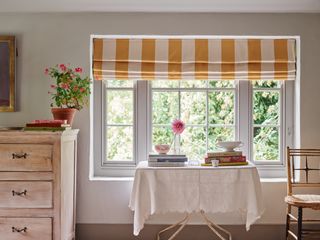How to make a Roman blind from a kit — see how our DIY expert got on
DIY expert Pete Wise shows you how to make a Roman blind from a kit with his step-by-step guide to brighten up a home

Wondering how to make a Roman blind? DIY expert Pete Wise is here to help, with his easy-to-follow, step-by-step guide.
Simpler than shutters, and softer than a slatted Venetian blind, a Roman blind could be just the window covering you’re looking for, working with a whole range ofwindow styles. This classic blind design, largely unchanged since ancient Roman times, employs a mechanism of rods and cords to operate a fabric blind that can fold up neatly at the top of the window.
有两种定义特征a Roman blind: the blind fabric itself, and the mechanism used to support and operate the blind. The fabric could be any suitable piece of material, adapted with a lining, rod pockets, and loops through which the blind cords can be threaded. Cotton, linen and jacquard fabrics are popular options.
Supporting the fabric is the blind mechanism. This includes a headrail from which the material is hung, rods and a bottom bar that give the blind its structure, cords that attach to the backs of the rods, and a chain which is used to open or close the folds of the blind. It sounds complicated, but works with a graceful simplicity.
Read on to find out how you can fit on of these blinds on a DIY basis.
How to make a Roman blind in four easy steps
My partner and I made our Roman blind from a kit very much likethese ones from Curtainsandblinds4homes, which included the blind mechanism plus some essential components for attaching the fabric, including sew-on rod pockets and velcro. In this guide, I’ll tell you how we turned our kit and fabric into a working Roman blind.
Before getting stuck in though, please be aware that Roman blind kits vary in their requirements. This article describes the steps involved in making a Roman blind from a kit — but you’ll also need to refer to your kit manufacturer’s instructions, in order to put your blind together properly.
Materials required
Essential items for installation:
- Roman blind mechanism kit
- Blind fabric
- Blind lining (e.g. white cotton; blackout)
- Pencil
- Sewing needle
- Thread
- Tape measure
- Spirit level or laser level
- Hammer drill
- Angle grinder (or another metal-cutting tool, if the headrail and rods need to be resized)
- Wall plugs and screws (if not included with Roman blind kit)
- Hammer
- Screwdriver
Additional items if preparing the blind fabric:
- Fabric scissors
- Sewing machine
- Pins
- Thread picker (in case of mistakes)
1. Prepare to fit the blind
Before you prepare the blind fabric, buy a blind mechanism with suitable dimensions. It should include a headrail that’s at least as wide as your window opening, and enough rods to support the desired ‘drop’ (which means the distance from the top of the fully closed blind to the bottom). Do keep yourwindow sill ideasin mind when measuring and choosing fabric.
接下来,需要选择面料和衬里height and width. Both measurements will be greater than the final width and drop of the blind, as the fabric must accommodate the blind mechanism. The instructions for your blind mechanism should say how much leeway is needed.
Prepare the fabric to cover your window. Following the instructions provided with your blind mechanism, attach the lining to the reverse of the blind fabric; add the sew-on pockets for the rods and bottom bar to the lining; and attach the velcro (included in the kit) to the top of the lining. To complete these tasks efficiently, you’ll need to use a sewing machine.

2. Integrate the mechanism
If your headrail, rods and bottom bar are wider than the window opening, you may want to cut them down to size before installation. I did this using an angle grinder and some metal snips — be sure to use the最好的角磨机for the job to get a neat finish.
Remember that the headrail will need to be a little wider than the blind fabric, as it also houses the open/close mechanism on one side of the blind. As for the rods and bottom bar, the relation of their width to that of the blind should be specified in the kit maker’s instructions.
Now, insert the rods and bottom bar into their pockets on the back of the blind, and sew up the openings at the ends of the pockets.
Lay the blind out face-down, and attach the velcro at the top of the lining to the velcro strip on the headrail. Then, untie the cords, which should be evenly spaced along the headrail. Thread the cords vertically through the best-placed loops on the backs of the rod pockets (except the bottom pocket), and secure the taut cords in place at the lowest threaded loop using the cord collectors included in your blind kit.



3. Fix the blind into position
Using the brackets provided with your Roman blind kit, fix the headrail to the wall above your window opening (or into the top of the window recess). Use a laser level or spirit level to find a straight, even line across the top of the window recess, then use a tape measure and pencil to mark where the brackets will be screwed into the wall. The exact placement will vary depending on your chosen blind kit.
When it comes to the best类型的钻to use here, I used a hammer drill. Drill into the marked places using a hammer drill with a masonry bit attached, then knock some wall plugs into the holes, and screw the brackets into the plugs. The brackets should be perfectly level and able to support the blind’s weight.
Finally, fix your headrail (with blind attached) to the brackets using the relevant method. With my blind kit, this is done using lockable levers on the brackets, which hook into a track on the headrail.



4. Finish off with extra touches
By this point, your blind should be operational. Try using the chain to close and open the blind. If everything’s correctly installed, the fabric will concertina into neat folds.
There are a few extra steps which you may want to take, now or at an earlier stage, in order to finish the blind to your liking.
For instance, you might want to cut the control chain down to a shorter length, and install a hook within the window recess to stow it safely. This is an important requirement for households where children or pets could get tangled up in the chain.
Depending on your taste, you may also decide to sew a decorative trim such as thisEmbroidered Woven Ribbon from Amazononto the bottom of the blind.

FAQs
What should I line my blinds with?
There are a few different types of lining commonly used to line blind fabric.
The most basic option is a white cotton lining. This is the type of lining I used with my blind, and it proved to be a simple, effective and budget-friendly choice.
If you’re looking for a lining that will help insulate the room, consider a thermal lining with a heat-retentive rubberised layer. Or, if your priority is to block out as much light as possible, then a blackout lining could be your best bet.

What is the easiest type of blind to make?
Swedish blinds are generally considered the easiest type of blind to make, since their fabric does not need to be fitted with rods or cords. At the other end of the spectrum, Venetian blinds with wooden slats would require a lot of time and skill to make from scratch.
Considered alongside other popular types of blind, Roman blinds are somewhere around the middle of the difficulty scale. Assuming you’re using a ready-made Roman blind kit, making a Roman blind is possible for DIYers who are confident in their sewing and fixing skills.

Pete Wise is a freelance writer and keen DIYer from Leeds. Pete's tool reviews have featured in titles including Homebuilding & Renovating, Ideal Home and The Independent. He also writes features and news articles for publications such as The Guardian, BBC Good Food and T3. When he isn't busy writing, Pete can often be found at libraries, pubs and live music venues. He finds tile-cutting strangely zen.
Get the Homebuilding & Renovating Newsletter
Bring your dream home to life with expert advice, how-to guides and design inspiration, direct to your inbox.
Pete Wise is a freelance writer and keen DIYer from Leeds. Pete's tool reviews have featured in titles including Homebuilding & Renovating, Ideal Home and The Independent. He also writes features and news articles for publications such as The Guardian, BBC Good Food and T3. When he isn't busy writing, Pete can often be found at libraries, pubs and live music venues. He finds tile-cutting strangely zen.
